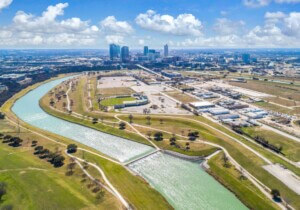The Trump administration is seeking to install a Buoy Barrier System (BBS) within sections of the Rio Grande River that form the international border between the United States and Mexico. The potential scheme is intended to halt water crossings of migrants entering the U.S. by swimming, often at their own peril, across often-dangerous parts of the river into Texas. The Rio Grande comprises roughly two-thirds of the 2,000-mile-long U.S.–Mexico border. The expansive river border is almost entirely located in Texas, with a small section also existing in New Mexico.
As reported by the Washington Post, the push for a floating border wall initially came to light via a solicitation posted by the U.S. Army Corps of Engineers that seeks market research information from private companies related to the procurement of a BBS that would be placed “along the southern border of the United States in a marine environment.” The solicitation stipulates that, among other things, that the system must be easily deployable, modifiable, and be able to “impede incursions via swimming, or via unassisted climb-over in water, yet be easily repaired in the event of breaches.” It should also, as detailed by the feasibility-pondering document, “include a component (such as an anti-dive mesh) that would impede incursions and/or breaching via underwater diving while minimizing debris build-up.” The system also must include an anchoring system able to withstand 25 metric tons.
“The U.S. government puts all sorts of buoys in the water that save lives by keeping boaters away from hazards or gathering weather data to predict storms,” David FitzGerald, co-director of the Center for Comparative Immigration Studies at the University of California at San Diego, explained to the Washington Post. “Imagine a floating wall explicitly designed to keep swimmers from holding on.”
The deadline for responses was August 19.
A network of buoy-anchored water barriers would be in addition to—and not replace—sections of the Trump administration’s $15 billion border wall, which Trump announced in May that he wanted painted black in its entirely. This aesthetically menacing overhaul could if executed, add an additional estimated $500 million to the overall construction tab. To date, 275 miles of not-always-foolproof barriers have been erected along the U.S.–Mexico border using roughly 587,000 tons of concrete and 404, 000 tons of steel.
Such immense terrestrial barriers located along ecologically sensitive shorelines are often technically difficult to build and, per the Washington Post, have been subject to intense resistance from private landowners along the Rio Grande.
One section of the border wall located in close proximately to the Rio Grande has also been a point of personal embarrassment for the president, which may explain why the administration now has its sights on floating alternatives. A still relatively new 3-mile stretch of border wall closely (emphasis on closely) abutting the Rio Grande that was erected by Fishers Industries is believed to have caused significant erosion and is now at imminent risk of falling into the river if not fixed.











